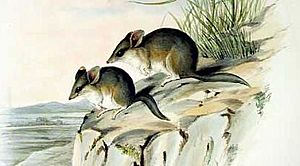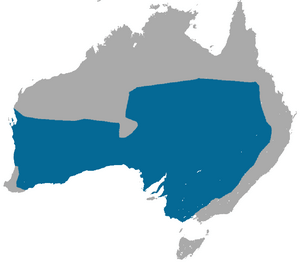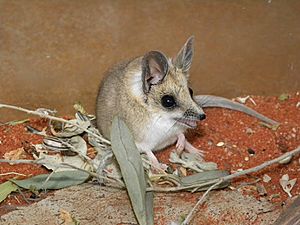Fat-tailed dunnart facts for kids
Quick facts for kids Fat-tailed dunnart |
|
|---|---|
 |
|
| Conservation status | |
| Scientific classification | |
| Genus: |
Sminthopsis
|
| Species: |
crassicaudata
|
 |
|
| Fat-tailed dunnart range | |
The fat-tailed dunnart (Sminthopsis crassicaudata) is a small, mouse-like marsupial. It belongs to the Dasyuridae family. This family also includes animals like quolls and the Tasmanian devil.
These dunnarts are quite small. Their body is usually about 60 to 90 millimeters (2.4 to 3.5 inches) long. Their tail adds another 45 to 70 millimeters (1.8 to 2.8 inches). Their ears are about 14 to 16 millimeters (0.55 to 0.63 inches) long. They are one of the smallest meat-eating marsupials. They weigh between 10 and 20 grams (0.35 to 0.71 ounces). Their tail gets thick a few millimeters from its base and stays thick to the tip. This thick tail is where they store fat. Many animals hunt fat-tailed dunnarts. These include foxes, cats, and other wild animals.
Contents
Where Do Fat-Tailed Dunnarts Live?
Fat-tailed dunnarts live in many different places across Australia. You won't find them in the Kimberley region of Western Australia. They also avoid northern parts of the Northern Territory, like Arnhem Land and Kakadu National Park. In Victoria, they don't live in the Wannon or Mallee scrub areas.
You can find them in grassy woodlands and areas with samphire shrubs. They also live in most Australian deserts. This includes the Simpson Desert and Gibson Desert.
What Kind of Homes Do They Like?
These dunnarts prefer places with sparse grasslands. They also like open shrublands and farmlands. They need areas where there is a lot of bare ground. Simple farming methods have actually helped these animals. They create the kind of open habitat dunnarts like. However, very intense farming can be bad for them.
Life Cycle and Reproduction
Fat-tailed dunnarts usually breed from July to February. The baby dunnarts stay in their mother's pouch from July to April. Pregnancy lasts about 13 days. The young stay in the pouch for about 70 days.
A mother dunnart usually has about 7 or 8 babies in a litter. About one-third of the babies might not survive. Females usually have two litters each year. They don't start breeding until they are one year old. Females live for about 18 months on average. Males usually live for about 15 months.
What Do Fat-Tailed Dunnarts Eat?
The fat-tailed dunnart eats mostly insects. This includes beetles and spiders. They also hunt small reptiles and amphibians. When food is hard to find, they use the fat stored in their carrot-shaped tail. This fat gives them energy.
How Do Fat-Tailed Dunnarts Survive?
Fat-tailed dunnarts are very good at living in harsh, dry places. They have special ways to save energy and find food.
Staying Safe at Night
First, these marsupials are nocturnal. This means they are active at night. Being awake at night protects them from the hot daytime temperatures. This helps them save energy. When they are awake, they spend most of their time looking for food. Each night, they eat about their own body weight in food! If there isn't much food, they spend less time active. But they hunt even harder during that shorter time. They have sharp teeth to grind their prey into tiny pieces. This helps them get all the nutrients from their food. They digest food quickly. The fat in their tail also gives them energy when food is scarce.
Using Daily Torpor
Another way they survive is by using something called daily torpor. This is like a mini-hibernation. They lower their body temperature and metabolic rate. This helps them use much less energy. Torpor is not affected by how long the day is. But it is greatly affected by the weather and food supply.
Two things must happen for a dunnart to go into torpor:
- The air temperature must be low.
- There must be a shortage of food.
They use torpor more often in winter. This is because food is harder to find. Also, it takes more energy to stay warm in the cold. During torpor, their body temperature can drop as low as 14.6°C (58.3°F). They don't stay in torpor for very long periods. So, their heart rate changes and doesn't become completely steady. This is different from animals that truly hibernate for a long time.
What's amazing is that dunnarts can use torpor even when they are growing or having babies. A mother dunnart can go into daily torpor even while feeding her young. This does not harm the babies.
Warming Up After Torpor
After waking up from torpor, they need to warm their bodies back up. This process needs a lot of energy. To help, these marsupials often look for sunny spots. They will bask in the sun to warm themselves faster.
Sharing Nests for Warmth
Nesting is another survival trick. When it's cold, fat-tailed dunnarts sometimes share nests with other animals. They might even share a nest with a household mouse! This helps them stay warm together. This is quite unusual because fat-tailed dunnarts usually hunt these mice when it's not so cold. They only share nests in groups when they are not breeding.
See also
 In Spanish: Ratón marsupial de cola gruesa para niños
In Spanish: Ratón marsupial de cola gruesa para niños



